Understanding Color Theory
Before you start creating a color palette, it’s important to have a basic understanding of color theory. Color theory is the science and art of using colors to evoke emotions and create visual harmony. It consists of the color wheel, which is a visual representation of colors and their relationships.
The color wheel is divided into primary colors (red, blue, and yellow), secondary colors (orange, green, and purple), and tertiary colors (yellow-orange, yellow-green, blue-green, blue-violet, red-violet, and red-orange). Understanding how these colors interact with each other is crucial in creating a vibrant color palette.
There are also different color schemes that you can use to create a vibrant color palette. These include complementary colors (colors that are opposite each other on the color wheel), analogous colors (colors that are next to each other on the color wheel), and triadic colors (colors that are evenly spaced on the color wheel).
Choosing Vibrant Colors
When creating a vibrant color palette, it’s important to choose colors that are bright, bold, and saturated. These colors are more eye-catching and can evoke a sense of energy and excitement. Using pastel or muted colors may result in a less vibrant palette.
Consider the emotions and messages you want your color palette to convey. Vibrant reds can evoke passion and strength, while vibrant yellows can convey excitement and optimism. Blues and greens can evoke feelings of calmness and freshness.
It’s also important to consider the context in which your color palette will be used. Different industries and audiences may have different preferences when it comes to color. For example, some industries may prefer more professional and subdued colors, while others may be more open to vibrant and energetic colors.
Experimenting with Color Combinations
Once you have a basic understanding of color theory and have chosen vibrant colors, it’s time to experiment with different color combinations. The goal is to create a palette that is visually appealing and harmonious.
Start by choosing a base color or two, and then experiment with different color schemes. For example, you can try complementary colors by pairing colors that are opposite each other on the color wheel. This can create a high contrast and energetic effect.
Analogous colors, on the other hand, can create a more harmonious and calming effect. These are colors that are next to each other on the color wheel. Triadic colors, which are evenly spaced on the color wheel, can create a balanced and vibrant palette.
Considering Accessibility and Brand Identity
When creating a vibrant color palette, it’s important to consider accessibility and brand identity. Ensure that the colors you choose have enough contrast to be easily readable, especially for text and important elements.
Also, consider your brand identity and how the color palette aligns with your brand. Colors have the power to evoke different emotions and associations, so choose colors that align with the values and personality of your brand.
It’s also worth considering the cultural connotations of colors. Different cultures may have different associations and meanings for certain colors. Take this into account if your brand has a global presence or is targeting specific cultural groups.
Refining and Testing Your Color Palette
Once you have experimented with different color combinations, it’s important to refine and test your color palette. Consider how the colors look together as a whole and ensure that they create the desired visual impact.
You can also test your color palette by applying it to different design elements, such as your website or marketing materials. This will give you a better sense of how the colors work in practice. Consider seeking feedback from others to get different perspectives on your color palette.
Remember that creating a vibrant color palette is a creative process, and it may take some trial and error to find the perfect combination. Trust your instincts and have fun with exploring different color possibilities!






